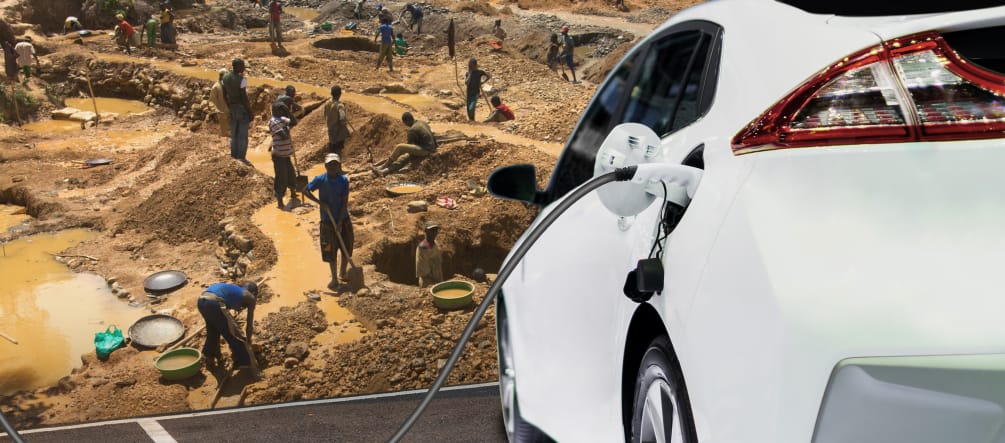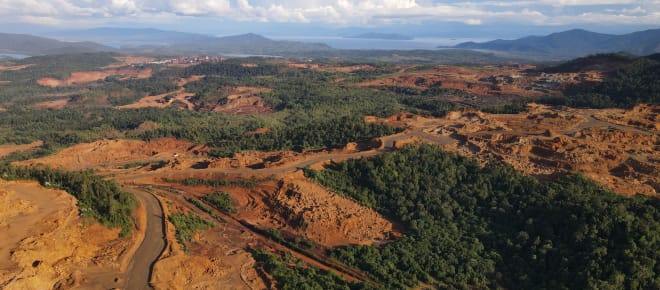
Electric vehicles are stealth rainforest killers!
The EU is pumping billions into promoting electric vehicles (EVs) – 200 million are expected to be on the road by 2028. But EVs are not as green as they are portrayed: their production consumes vast amounts of cobalt, nickel, manganese and rare earths that are mined in the rainforests of Africa, Southeast Asia and South America.
News and updatesTo: The EU and the governments of the Member States
“Simply replacing internal combustion engines with electric motors is not the answer – we need to create new mobility concepts from the ground up.”While the emissions of conventional cars are terrible for the environment and human health, electric vehicles are anything but clean – their production requires an enormous input of energy and raw materials.
About 1,800 kilograms of metals and other materials are used in a mid-range electric car such as the Chevrolet Bolt, which marketed in Europe as the Vauxhall/Opel Ampera-e. The European automotive industry imports almost 100% of these materials – and a significant share of them come from mines in tropical countries and rainforest areas.
Lithium-ion batteries, the heart of electric vehicles, are no exception here. The Chevrolet Volt battery pack, for example, weighs 440 kg, which is 10,000 times the weight of a smartphone battery (44 gr). Besides lithium, manganese and graphite, they contain about 10 kg of cobalt and 30 kg of nickel.
In the case of nickel mining, Indonesia and the Philippines are at the forefront of global production. Two-thirds of the world's cobalt comes from the Democratic Republic of Congo. Cobalt, copper and nickel are mined along an 800-kilometer belt in the rainforest in the south of the country – under catastrophic working conditions, at starvation wages, and by tens of thousands of child laborers.
In the case of iron for steelmaking, Brazil is a leading supplier of the automotive industry. The country is also in first place for copper, followed by Peru and Chile.
The mines of international corporations are thus eating into the rainforests to satisfy the resource hunger of the manufacturers of “clean” electric vehicles.
Simply clogging the roads with millions of EVs is not the answer to our present problems. Tell the EU that we need a fundamental rethink of policies related to raw materials and transport to put them on an environmentally friendly foundation.
Battery production as a driver for economic growth
There are currently four million electric cars worldwide. According to estimates by the European Commission, this figure is expected to rise to 200 million by 2028. Electric vehicles are expected to give a strong boost to economic growth.
Before an electric vehicle even rolls out of the factory, the mining and processing of raw materials required for its production causes enormous damage to the environment and human health. Most electric cars operate with synchronous motors with neodymium-iron-boron magnets. These contain so-called rare earths such as dysprosium, neodymium, praseodymium and terbium, which are mainly mined in China. The chemicals used in the process produce large quantities of toxic sludge and mine tailings.
The nickel manganese cobalt (NMC) battery of a mid-range car like the Chevrolet Bolt, the most popular electric car since 2017, weighs about 440 kg.
Batteries for smartphones weigh just over 40 gr (e.g. Apple iPhone XS 41 gr (0.041 kg); Samsung states the weight of the standard battery for its smartphones at 43 gr (0.043 kg), which means that the battery of a mid-range electric car weighs about 10,500 times as much as a smartphone battery.
Battery production is considered a key technology for electric vehicles. Up to now, European automobile manufacturers have been buying the lithium-ion batteries needed for electric cars in China, Korea and Japan. Only 3% of lithium-ion batteries are produced in the EU.
The European Commission has called for quick action to conquer the new European market for batteries worth an estimated 250 billion euros annually from 2025, while the European automotive industry – with companies such as BMW, Daimler, PSA (Peugeot, Opel and Citroen), Renault and Volkswagen – are putting pressure on their respective governments and the EU. Volkswagen alone wants to offer a total of 80 different electric models by 2030. The group plans to invest up to 50 billion euros in the battery business.
The European Battery Alliance
In October 2017, the EU created the European Battery Alliance. Its purpose is to use public funds to set up battery production facilities. To this end, 20 to 30 so-called giga-factories are to be built in the EU with the participation of the world’s largest battery companies, such as CATL from China and South Korea’s LG Chem.
Almost all of the raw materials required for battery production need to be imported. A mid-range electric car contains about 80 kg of copper, 30 kg of nickel, 30 kg of graphite, 10-20 kg of lithium, 10 kg of manganese and 8 kg of cobalt.
In May 2018, the EU launched the Strategic Action Plan on Batteries as part of its Europe on the Move development package.
The Action Plan intends to “secure access to raw materials from resource-rich countries outside the EU [and] facilitate access to European sources of raw materials”. The European Commission is calling on its Member States to intensify their support for battery production projects, to provide the necessary financial resources and to simplify and accelerate the approval procedures for mining and processing the required raw materials.
Electric mobility means even more cars
Electric vehicles require a vast amount of power that currently cannot be generated in an environmentally friendly manner. And due to their short range, electric vehicles are often second or third cars, used primarily for short trips in town. For longer distances, cars with internal combustion engines continue to be used – including an increasing number of “sports utility vehicles” (SUVs).
To: The EU and the governments of the Member States
Ladies and Gentlemen,
A wholesale shift to electric vehicles is neither environmentally sound nor climate-neutral. It would require a vast amount of power that currently cannot be generated in an environmentally friendly manner.
The production of electric cars requires enormous amounts of raw materials that are almost exclusively mined in tropical countries and rainforest areas.
Furthermore, the switch to electric mobility will not bring about a decline in road traffic, as the constantly rising number of vehicle registrations and increasing road congestion show.
We call on you to work to reduce the number of cars and car traffic. Ensure that people can reach their destinations quickly and safely on foot, by bike or by public transport.
We call on you to create create effective new mobility concepts that benefit people and nature.
Yours faithfully,

Sulawesi Alliance, a group of environmental and human rights organizations working locally, will be delivering a statement to the G20 meeting in Bali about the destructive nature of nickel production in Indonesia for the energy transition. They call on world powers to stop investing in the mining sector, specifically nickel mining. Nickel is one of the components in electric batteries.
The production of electric vehicles requires vast amounts of raw materials such as nickel: Around 32 kg of this metal are needed for the lithium batteries of a mid-range car. To secure access, Tesla CEO Elon Musk is encouraging global nickel mining and is considering investing in the mining industry in Indonesia and elsewhere.